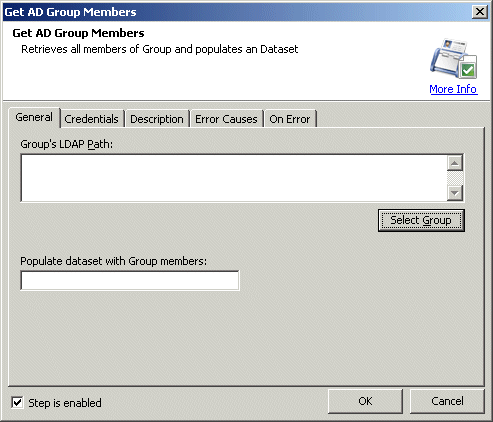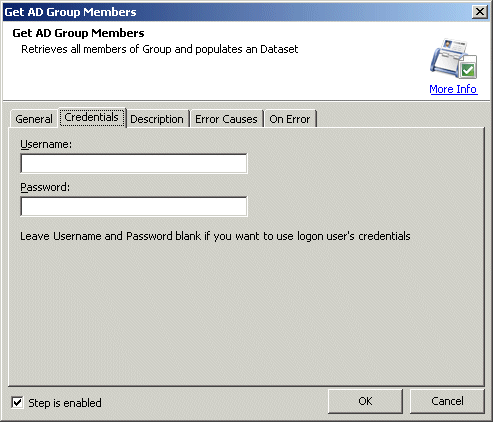Description
Populates a dataset with all of the members of an AD Group.
Declaration
<GETADGROUP LDAPPATH="text" GROUP="text" DISPLAYNAME="text" DESCRIPTION="text" GROUPTYPE="text [options]" GROUPSCOPE="text [options]" USERNAME="text" PASSWORD="text"/>
Example
<GETADGROUP LDAPPATH="LDAP://servtest.com" USERNAME="administrator" PASSWORD="password" GROUP="BPA" DISPLAYNAME="BPA" DESCRIPTION="Business Process" GROUPTYPE="SECURITY" GROUPSCOPE="DOMAINLOCAL" />
General Tab Parameters

Group's LDAP Path: Allows you to enter the LDAP path of the parent active directory object. Usually the top most container or rootdse path.
Text, Required
MARKUP: LDAPPATH="LDAP://DC=networkautomation,DC=com"
Click Select Group to select the group from the domain. When you do, this launches a standard Windows Active Directory dialog box that allows you to select the group.
Populate variable with path: Variable is populated with the first object's LDAP path found in Active Directory matching the name.
Text [variable name], Required
MARKUP: RESULTVARIABLE="varname"
Credentials Tab Parameters

Username: Allows you to enter the name of the active directory user.
Text, Optional
MARKUP: USERNAME="username"
Password: Allows you to enter the password of the active directory user.
Text, Optional
MARKUP: PASSWORD="password"
Note: Leave these fields blank if you want to use current user's credentials. If you are trying to access the active directory information then any Domain user is valid but in order to modify the user or group you need Domain Administrator. We recommend to use domain administrator for all the active directory actions.
Refer to the following link for more information: http://en.wikipedia.org/wiki/Lightweight_Directory_Access_Protocol